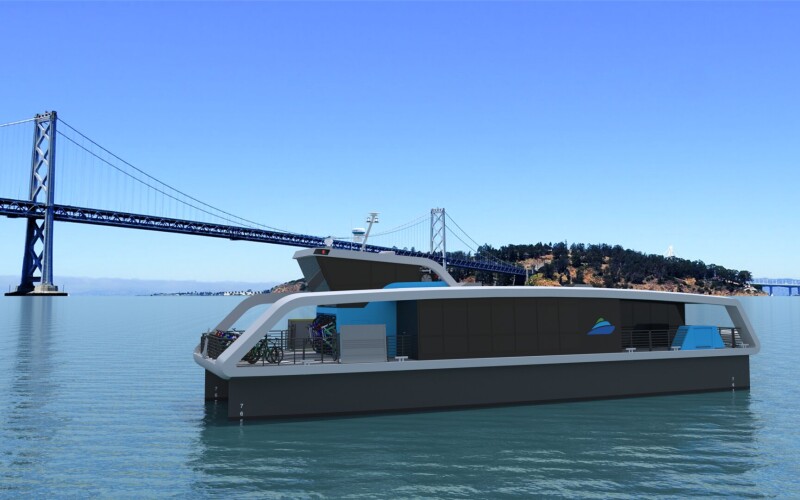Ferries have come a long way in the San Francisco Bay transportation system since John Reed, an Irish immigrant, established a ferry service in 1826. Reed’s vessel of choice was a sailboat he sailed in the Oakland estuary. Over the years, that sailboat would be followed by a variety of vessels, many of which had originated elsewhere but ultimately served to transport people across San Francisco Bay.
Passenger ferry service began operating between Oakland, Calif., and San Francisco in 1851 with the sternwheel Sacramento River packet General Sutter. Two years later, the Clinton was California’s first steam ferry, a 120'x24' side-wheel steamer, powered by a 125-hp low-pressure engine and built for trans-bay service. In 1909, the Melrose was launched as the first San Francisco Bay ferry built with an unobstructed lower deck specifically intended for automobiles and an upper deck for passengers.
The latest in the lineup of breakthrough designs will be a 92'3"x26'x5'7", 155-passenger, battery-electric powered, aluminum catamaran ferry for San Francisco’s Water Emergency Transportation Authority, the operator of the San Francisco Bay Ferry System. All American Marine, Bellingham, Wash., has been contracted to build three 155-passenger ferries for a total of $46 million. There is an option for a fourth. Aurora Marine Design (AMD), based in San Diego, led the conceptual design, and New Zealand-based Teknicraft Design will work with AAM as the naval architect.
As of mid-December, no designer or builder had been selected for the larger, 400-passenger, ferries. Though Seattle’s Elliott Bay Design Group will be the construction manager, the actual design will be left up to the shipyard building the boat. The only stipulation is that “it should look something similar to the smaller boat,” said Green.
LIGHT ’EM UP
The 155-passenger and 400-passenger ferries will be the U.S.’s fi rst high-speed, battery-electric ferries. Delivery of the first ferry — an Aurora 92-footer — is expected in mid-2026.
“The impetus for the design,” said Green, “is that San Francisco Bay Ferry is committed to zero emissions in its whole fleet by 2035.” San Francisco Mayor London Breed said in a Nov. 1 press release that the city was receiving a $55 million grant from the Environmental Protection Agency for completing “the nation’s first-ever, high-speed, zero-emission ferry network connecting critical transportation hubs.”
Ferries emerging from the designers’ boards to fulfill this vision will be vastly different from ferries available today. To start with, the battery-electric ferries will be “sort of a unique experience. They are quieter and you hear other things,” noted Green.
The source of that “quiet” for the three 92' catamaran ferries will be a propulsion package provided by Wärtsilä that includes a pair of 219-kW battery packs, one in each hull, each matched up to a 625-kW electric motor that powers a 360°, high-speed Hydromaster azimuthing stern thruster.
Besides being quieter than the conventional propulsion package, “It will decrease docking time and greatly decrease the amount of energy used,” said Green. “Theoretically, fully loaded, it should be capable of 26 knots but will probably run in the 23-knot range.”
The closest thing in Europe, said Green, is the fully electric, 147' passenger ferry Medstraum, which was delivered to operator Kolumbus in 2022 and is said to be reducing emissions by up to 1,500 tons per year on the commuter route between Stavanger and Hommersåk on the west coast of Norway. San Francisco’s new 92' ferries should produce “93.3% less emissions. That’s the savings over the renewable diesel that ferries are currently using,” said Green.
The batteries for the San Francisco Bay 92-footers were selected by Wärtsilä after what Green said was “a big evaluation of all the batteries out there.”
Sweden-based Echandia announced in August that it will supply the battery systems from its new production facility in Marysville, Wash., targeting delivery in 2025.
“The battery vendor we selected has a battery chemistry you can really abuse,” Green said, noting a quick charging turnaround time. Green estimates the turnaround time to be six to seven minutes for the entire boat, and “the batteries’ lifespan is two to three times that of equivalent batteries.”
The ability to quickly recharge a battery “allows you to have a much smaller battery on board and be a lot safer,” added Green. It also means a lighter boat. The batteries going into each 92-footer should have a total weight of 15,400 lbs. That’s compared to 22,000 lbs., which Green said is about what “normal batteries would weigh.”
All boats in San Francisco’s WETA fleet will have the same propulsion system. Smaller boats will have one propulsion unit per hull. The 400-passenger ferries get the same propulsion, just two units per hull. “Standardization was one of the big, big highlights of the thing,” said Green. “We spent a lot of time making sure we could make that happen.”
Standardization cuts down on the number of spare parts that need to be stored. If a thruster needs to be replaced in the 155-passenger ferry, a spare from one of the 400-passenger ferries can be used. “It has the same gear ratio, the same everything,” said Green.
If the propulsion system for San Francisco’s new ferries makes them vastly different from what powers the current ferries, so, too, does the interior design, which Green said is derived from shoreside industrial designs, as opposed to standard ferry layouts. “We spent time with WETA asking how we can improve the passenger’s experience on board and save weight at the same time,” said Green. “They were looking for a different feel on board — more of an enhanced passenger experience, more lounge-like, less school-bus-feeling. They wanted something that was new, exciting and interesting.”
Thus the 92-footers will have what Green said is a more “lounge-style seating [arrangement], more like you see in a bar,” as opposed to “three to four in a row seating.” In fact, the design calls for “a lot of barstool-type seating.”
When you look at the main deck layout, there’s a lot of barstools drawn in. “Passengers come aboard and literally plunk themselves down on a barstool and look out through really large windows, almost floor-to-ceiling windows. You’ll be more connected to the outside world and the water outside,” said Green.
Green said the interior design works especially well on shorter runs. “People don’t want to take the time to squeeze between other people and find a middle seat,” he said.
CHARGING FLOAT
The float where the Aurora Marine-designed 92-footers will tie up is different from the usual ferry tie-up. The float contains a full electrical power management system.
“It takes like 12,000 volts from shore in the trunk of the float and converts [it] into DC for charging the ferry and AC for running all firefighting and pumps and 1.3 MW of batteries in the float,” said Green. "We designed and made the float that contains all the equipment on the inside, so visually it's not impactful." That was important because San Francisco didn't want 40' containers packed with electronic equipment along its downtown docks, creating a public eyesore.




